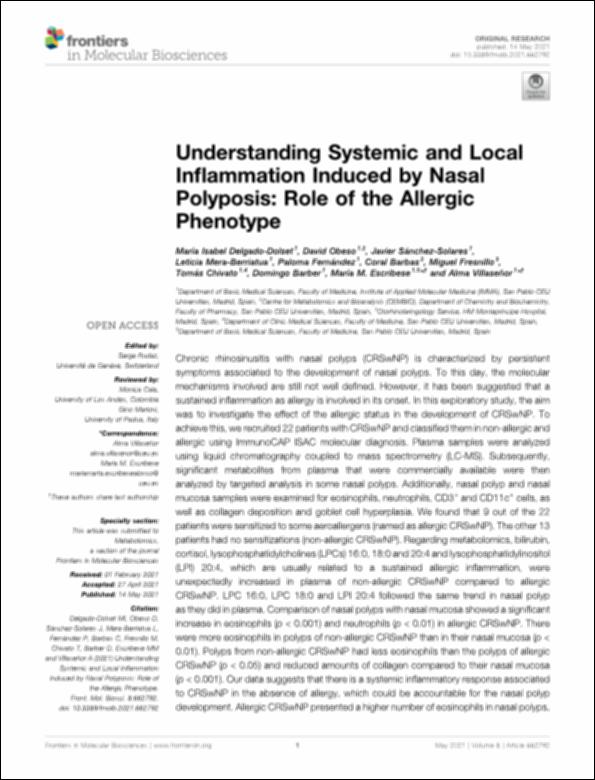Por favor, use este identificador para citar o enlazar este ítem:
http://hdl.handle.net/10637/13006Understanding Systemic and Local Inflammation Induced by Nasal Polyposis : Role of the Allergic Phenotype.
| Título : | Understanding Systemic and Local Inflammation Induced by Nasal Polyposis : Role of the Allergic Phenotype. |
| Autor : | Delgado Dolset, María Isabel Barber Hernández, Domingo Obeso Montero, David Villaseñor Solis, Alma Cristina Chivato Pérez, Tomás Escribese Alonso, María Marta |
| Materias: | Metabolomics; Nasal polyps; Allergy; Targeted analysis; Untargeted analysis |
| Resumen : | Chronic rhinosinusitis with nasal polyps (CRSwNP) is characterized by persistent symptoms associated to the development of nasal polyps. To this day, the molecular mechanisms involved are still not well defined. However, it has been suggested that a sustained inflammation as allergy is involved in its onset. In this exploratory study, the aim was to investigate the effect of the allergic status in the development of CRSwNP. To achieve this, we recruited 22 patients with CRSwNP and classified them in non-allergic and allergic using ImmunoCAP ISAC molecular diagnosis. Plasma samples were analyzed using liquid chromatography coupled to mass spectrometry (LC-MS). Subsequently, significant metabolites from plasma that were commercially available were then analyzed by targeted analysis in some nasal polyps. Additionally, nasal polyp and nasal mucosa samples were examined for eosinophils, neutrophils, CD3+ and CD11c+ cells, as well as collagen deposition and goblet cell hyperplasia. We found that 9 out of the 22 patients were sensitized to some aeroallergens (named as allergic CRSwNP). The other 13 patients had no sensitizations (non-allergic CRSwNP). Regarding metabolomics, bilirubin, cortisol, lysophosphatidylcholines (LPCs) 16:0, 18:0 and 20:4 and lysophosphatidylinositol (LPI) 20:4, which are usually related to a sustained allergic inflammation, were unexpectedly increased in plasma of non-allergic CRSwNP compared to allergic CRSwNP. LPC 16:0, LPC 18:0 and LPI 20:4 followed the same trend in nasal polyp as they did in plasma. Comparison of nasal polyps with nasal mucosa showed a significant increase in eosinophils (p < 0.001) and neutrophils (p < 0.01) in allergic CRSwNP. There were more eosinophils in polyps of non-allergic CRSwNP than in their nasal mucosa (p < 0.01). Polyps from non-allergic CRSwNP had less eosinophils than the polyps of allergic CRSwNP (p < 0.05) and reduced amounts of collagen compared to their nasal mucosa (p < 0.001). Our data suggests that there is a systemic inflammatory response associated to CRSwNP in the absence of allergy, which could be accountable for the nasal polyp development. Allergic CRSwNP presented a higher number of eosinophils in nasal polyps, suggesting that eosinophilia might be connected to the development of nasal polyps in this phenotype. |
| Descripción : | Artículo en colaboración con: D. Obeso, J. Sánchez-Solares, L. Mera-Berriatua, P. Fernández, C. Barbas, M. Fresnillo, T. Chivato, D. Barber, M.M. Escribese, A. Villaseñor En: Frontiers in Molecular Bioscience. ISSN 2296-889 2021, May 14, 8: 662792 |
| URI : | http://hdl.handle.net/10637/13006 |
| Derechos: | http://creativecommons.org/licenses/by-nc-nd/4.0/deed.es |
| Fecha de publicación : | 16-sep-2021 |
| Centro : | Universidad San Pablo-CEU |
| Aparece en las colecciones: | Facultad de Farmacia |
Los ítems de DSpace están protegidos por copyright, con todos los derechos reservados, a menos que se indique lo contrario.


